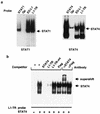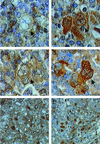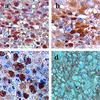Linkage between STAT regulation and Epstein-Barr virus gene expression in tumors
- PMID: 11222718
- PMCID: PMC115919
- DOI: 10.1128/JVI.75.6.2929-2937.2001
Linkage between STAT regulation and Epstein-Barr virus gene expression in tumors
Abstract
Epstein-Barr virus (EBV) latency gene expression in lymphoblastoid cell lines is regulated by EBNA2. However, the factors regulating viral expression in EBV-associated tumors that do not express EBNA2 are poorly understood. In EBV-associated tumors, EBNA1 and frequently LMP1 are synthesized. We found that an alternative latent membrane protein 1 (LMP1) promoter, L1-TR, located within the terminal repeats is active in both nasopharyngeal carcinoma and Hodgkin's disease tissues. Examination of the L1-TR and the standard ED-L1 LMP1 promoters in electrophoretic mobility shift assays revealed that both promoters contain functional STAT binding sites. Further, both LMP1 promoters responded in reporter assays to activation of JAK-STAT signaling. Cotransfection of JAK1 or v-Src or treatment of cells with the cytokine interleukin-6 upregulated expression from ED-L1 and L1-TR reporter plasmids. Cotransfection of a dominant negative STAT3 beta revealed that STAT3 is likely to be the biologically relevant STAT for EBNA1 Qp and LMP1 L1-TR promoter regulation. In contrast, LMP1 expression from ED-L1 was not abrogated by STAT3 beta, indicating that the two LMP1 promoters are regulated by different STAT family members. Taken together with the previous demonstration of JAK-STAT activation of Qp driven EBNA1 expression, this places two of the EBV genes most commonly expressed in tumors under the control of the same signal transduction pathway. Immunohistochemical analyses of nasopharyngeal carcinoma tumors revealed that STAT3, STAT5, and STAT1 are constitutively activated in these tumors while STAT3 is constitutively activated in the malignant cells of Hodgkin's disease. We hypothesize that chronic or aberrant STAT activation may be both a necessary and predisposing event for EBV-driven tumorigenesis in immunocompetent individuals.
Figures









Similar articles
-
A positive autoregulatory loop of LMP1 expression and STAT activation in epithelial cells latently infected with Epstein-Barr virus.J Virol. 2003 Apr;77(7):4139-48. doi: 10.1128/jvi.77.7.4139-4148.2003. J Virol. 2003. PMID: 12634372 Free PMC article.
-
The Epstein-Barr virus latency BamHI-Q promoter is positively regulated by STATs and Zta interference with JAK/STAT activation leads to loss of BamHI-Q promoter activity.Proc Natl Acad Sci U S A. 1999 Aug 3;96(16):9339-44. doi: 10.1073/pnas.96.16.9339. Proc Natl Acad Sci U S A. 1999. PMID: 10430944 Free PMC article.
-
NF-κB Signaling Regulates Expression of Epstein-Barr Virus BART MicroRNAs and Long Noncoding RNAs in Nasopharyngeal Carcinoma.J Virol. 2016 Jun 24;90(14):6475-88. doi: 10.1128/JVI.00613-16. Print 2016 Jul 15. J Virol. 2016. PMID: 27147748 Free PMC article.
-
Nasal NK- and T-cell lymphomas share the same type of Epstein-Barr virus latency as nasopharyngeal carcinoma and Hodgkin's disease.Int J Cancer. 1996 Nov 4;68(3):285-90. doi: 10.1002/(SICI)1097-0215(19961104)68:3<285::AID-IJC3>3.0.CO;2-Y. Int J Cancer. 1996. PMID: 8903467
-
Novel roles and therapeutic targets of Epstein-Barr virus-encoded latent membrane protein 1-induced oncogenesis in nasopharyngeal carcinoma.Expert Rev Mol Med. 2015 Aug 18;17:e15. doi: 10.1017/erm.2015.13. Expert Rev Mol Med. 2015. PMID: 26282825 Review.
Cited by
-
Tofacitinib induces G1 cell-cycle arrest and inhibits tumor growth in Epstein-Barr virus-associated T and natural killer cell lymphoma cells.Oncotarget. 2016 Nov 22;7(47):76793-76805. doi: 10.18632/oncotarget.12529. Oncotarget. 2016. PMID: 27732937 Free PMC article.
-
Upregulation of STAT3 marks Burkitt lymphoma cells refractory to Epstein-Barr virus lytic cycle induction by HDAC inhibitors.J Virol. 2010 Jan;84(2):993-1004. doi: 10.1128/JVI.01745-09. Epub 2009 Nov 4. J Virol. 2010. PMID: 19889776 Free PMC article.
-
Epstein-Barr virus and nasopharyngeal carcinoma.Chin J Cancer. 2014 Dec;33(12):581-90. doi: 10.5732/cjc.014.10197. Epub 2014 Nov 21. Chin J Cancer. 2014. PMID: 25418193 Free PMC article.
-
Signaling pathways of EBV-induced oncogenesis.Cancer Cell Int. 2021 Feb 6;21(1):93. doi: 10.1186/s12935-021-01793-3. Cancer Cell Int. 2021. PMID: 33549103 Free PMC article. Review.
-
IL-21 imposes a type II EBV gene expression on type III and type I B cells by the repression of C- and activation of LMP-1-promoter.Proc Natl Acad Sci U S A. 2010 Jan 12;107(2):872-7. doi: 10.1073/pnas.0912920107. Epub 2009 Dec 22. Proc Natl Acad Sci U S A. 2010. PMID: 20080768 Free PMC article.
References
-
- Ambinder R F, Robertson K D, Tao Q. DNA methylation and the Epstein-Barr virus. Semin Cancer Biol. 1999;9:369–375. - PubMed
-
- Bonnet M, Guinebretiere J M, Kremmer E, Grunewald V, Benhamou E, Contesso G, Joab I. Detection of Epstein-Barr virus in invasive breast cancers. J Natl Cancer Inst. 1999;91:1376–1381. - PubMed
-
- Bowman T, Garcia R, Turkson J, Jove R. STATs in oncogenesis. Oncogene. 2000;19:2474–2488. - PubMed
-
- Bromberg J F, Wrzeszczynska M H, Devgan G, Zhao V, Pestell R G, Albanese C, Darnell J E., Jr Stat3 as an oncogene. Cell. 1999;98:295–303. - PubMed
Publication types
MeSH terms
Substances
Grants and funding
LinkOut - more resources
Full Text Sources
Other Literature Sources
Medical
Research Materials
Miscellaneous

